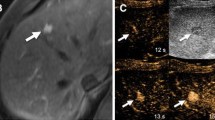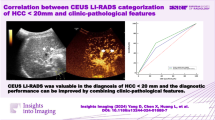Abstract
Objective
Non-simple nodules in hepatocellular carcinoma (HCC) correlate with poor prognosis. Therefore, we examined the diagnostic ability of gadolinium-ethoxybenzyl-diethylenetriamine pentaacetic acid-enhanced magnetic resonance imaging (EOB-MRI) and contrast-enhanced ultrasound (CEUS) for diagnosing the macroscopic classification of small HCCs.
Methods
A total of 85 surgically resected nodules (≤30 mm) were analyzed.
HCCs were pathologically classified as simple nodular (SN) and non-SN. By evaluating hepatobiliary phase (HBP) of EOB-MRI and Kupffer phase of CEUS, the diagnostic abilities of both modalities to correctly distinguish between SN and non-SN were compared.
Results
Forty-six nodules were diagnosed as SN and the remaining 39 nodules as non-SN. The area under the ROC curve (AUROCs, 95 % confidence interval) for the diagnosis of non-SN were EOB-MRI, 0.786 (0.682–0.890): CEUS, 0.784 (0.679–0.889), in combination, 0.876 (0.792–0.959). The sensitivity, specificity, and accuracy were 64.1 %, 95.7 %, and 81.2 % in EOB-MRI, 56.4 %, 97.8 %, and 78.8 % in CEUS, and 84.6 %, 95.7 %, and 90.6 % in combination, respectively. High diagnostic ability was obtained when diagnosed in both modalities combined. The sensitivity was especially statistically significant compared to CEUS.
Conclusion
Combined diagnosis by EOB-MRI and CEUS can provide high-quality imaging assessment for determining non-SN in small HCCs.
Key Points
• Non-SN has a higher frequency of MVI and intrahepatic metastasis than SN.
• Macroscopic classification is useful to choose the treatment strategy for small HCCs.
• Diagnostic ability for macroscopic findings of EOB-MRI and CEUS were statistically equal.
• The diagnosis of macroscopic findings by individual modality has limitations.
• Combined diagnosis of EOB-MRI and CEUS provides high diagnostic ability.





Similar content being viewed by others
Explore related subjects
Discover the latest articles and news from researchers in related subjects, suggested using machine learning.Abbreviations
- AFP:
-
Alpha-fetoprotein
- AP:
-
Arterial-phase
- AUROC:
-
Area under the receiver operating characteristic curve
- CECT:
-
Contrast-enhanced computed tomography
- CEUS:
-
Contrast-enhanced ultrasound
- CMN:
-
Confluent multinodular type
- DCP:
-
Des-γ-carboxyprothrombin
- EOB-MRI:
-
Gadolinium-ethoxybenzyl-diethylenetriamine pentaacetic acid-enhanced magnetic resonance imaging
- Gd-EOB-DTPA:
-
Gadolinium-ethoxybenzyl-diethylenetriamine pentaacetic acid
- HBP:
-
Hepatobiliary phase
- HBV:
-
Hepatitis B virus
- HCC:
-
Hepatocellular carcinoma
- HCV:
-
Hepatitis C virus
- ICG R15:
-
Indocyanine green retention rate at 15 minutes
- IF:
-
Infiltrative type
- MVI:
-
Microvascular invasion
- NBNC:
-
Patients negative for both HBs antigen and HCV antibody
- NPV:
-
Negative predictive value
- PPV:
-
Positive predictive value
- PVP:
-
Portal venous-phase
- ROC:
-
Receiver operating characteristic
- SN:
-
Simple nodular
- SN-DM:
-
Simple nodular type with distinct margin
- SN-EG:
-
Simple nodular type with extranodular growth
- SN-IN:
-
Small nodular type with indistinct margin
- US:
-
Ultrasound
References
Shimada K, Sakamoto Y, Esaki M et al (2007) Analysis of prognostic factors affecting survival after initial recurrence and treatment efficacy for recurrence in patients undergoing potentially curative hepatectomy for hepatocellular carcinoma. Ann Surg Oncol 14:2337–2347
Shah SA, Cleary SP, Wei AC et al (2007) Recurrence after liver resection for hepatocellular carcinoma: risk factors, treatment, and outcomes. Surgery 141:330–339
Dupont-Bierre E, Compagnon P, Raoul JL, Fayet G, de Lajarte-Thirouard AS, Boudjema K (2005) Resection of hepatocellular carcinoma in non-cirrhotic liver: analysis of risk factors for survival. J Am Coll Surg 201:663–670
Kaibori M, Ishizaki M, Saito T, Matsui K, Kwon AH, Kamiyama Y (2009) Risk factors and outcome of early recurrence after resection of small hepatocellular carcinomas. Am J Surg 198:39–45
Kanai T, Hirohashi S, Upton MP et al (1987) Pathology of small hepatocellular carcinoma: a proposal for a new gross classification. Cancer 60:810–819
Nakashima Y, Nakashima O, Tanaka M, Okuda K, Nakashima M, Kojiro M (2003) Portal vein invasion and intrahepatic micrometastasis in small hepatocellular carcinoma by gross type. Hepatol Res 26:142–147
Hui AM, Takayama T, Sano K et al (2000) Predictive value of gross classification of hepatocellular carcinoma on recurrence and survival after hepatectomy. J Hepatol 33:975–979
Sumie S, Kuromatsu R, Okuda K et al (2008) Microvascular invasion in patients with hepatocellular carcinoma and its predictable clinicopathological factors. Ann Surg Oncol 15:1375–1382
Ueno S, Kudo F, Sakoda M et al (2008) Efficacy of anatomic resection vs nonanatomic resection for small nodular hepatocellular carcinoma based on gross classification. J Hepatobiliary Pancreat Surg 15:493–500
Ariizumi S, Kitagawa K, Kotera Y et al (2011) A non-smooth tumor margin in the hepatobiliary phase of gadoxetic acid disodium (Gd-EOB-DTPA)-enhanced magnetic resonance imaging predicts microscopic portal vein invasion, intrahepatic metastasis, and early recurrence after hepatectomy in patients with hepatocellular carcinoma. J Hepatobiliary Pancreat Sci 18:575–585
Tsujita E, Yamashita Y, Takeishi K et al (2013) The clinicopathological impact of gross classification on solitary small hepatocellular carcinoma. Hepatogastroenterology 60:1726–1730
Vogl TJ, Kümmel S, Hammerstingl R et al (1996) Liver tumors: comparison of MR imaging with Gd-EOB-DTPA and Gd-DTPA. Radiology 200:59–67
Huppertz A, Balzer T, Blakeborough A et al (2004) Improved detection of focal liver lesions at MR imaging: multicenter comparison of gadoxetic acid-enhanced MR images with intraoperative findings. Radiology 230:266–275
Huppertz A, Haraida S, Kraus A et al (2005) Enhancement of focal liver lesions at gadoxetic acid-enhanced MR imaging: correlation with histopathologic findings and spiral CT-initial observations. Radiology 234:468–478
Saito K, Kotake F, Ito N et al (2005) Gd-EOB-DTPA-enhanced MRI for hepatocellular carcinoma: quantitative evaluation of tumor enhancement in hepatobiliary phase. Magn Reson Med Sci 4:1–9
Bluemke DA, Sahani D, Amendola M et al (2005) Efficacy and safety of MR imaging with liver-specific contrast agent: U.S. multicenter phase III study. Radiology 237:89–98
Hammerstingl R, Huppertz A, Breuer J et al (2008) Diagnostic efficacy of gadoxetic acid (Primovist) –enhanced MRI and spiral CT for a therapeutic strategy: comparison with intraoperative and histopathologic findings in focal liver lesions. Eur Radiol 18:457–467
Solbiati L, Tonolini M, Cova L, Goldberg SN (2001) The role of contrast-enhanced ultrasound in the detection of focal liver leasions. Eur Radiol 11:E15–E26
Konopke R, Bunk A, Kersting S (2007) The role of contrast-enhanced ultrasound for focal liver lesion detection: an overview. Ultrasound Med Biol 33:1515–1526
Yanagisawa K, Moriyasu F, Miyahara T, Yuki M, Iijima H (2007) Phagocytosis of ultrasound contrast agent microbubbles by Kupffer cells. Ultrasound Med Biol 33:318–325
Korenaga K, Korenaga M, Furukawa M, Yamasaki T, Sakaida I (2009) Usefulness of sonazoid contrast-enhanced ultrasonography for hepatocellular carcinoma: comparison with pathological diagnosis and superparamagnetic iron oxide magnetic resonance images. J Gastroenterol 44:733–741
Granito A, Galassi A, Piscaglia F et al (2013) Impact of gadoxetic acid (Gd-EOB-DTPA)-enhanced magnetic resonance on the non-invasive diagnosis of small hepatocellular carcinoma: a prospective study. Aliment Pharmacol Ther 37:355–363
Mita K, Kim SR, Kudo M et al (2010) Diagnostic sensitivity of imaging modalities for hepatocellular carcinoma smaller than 2 cm. World J Gastroenterol 16:4187–4192
Hatanaka K, Minami Y, Kudo M, Inoue T, Chung H, Haji S (2014) The gross classification of hepatocellular carcinoma: usefulness of contrast-enhanced US. J Clin Ultrasound 42:1–8
Tada T, Kumada T, Toyoda H et al (2014) Diagnostic accuracy for macroscopic classification of nodular hepatocellular carcinoma: comparison of gadolinium ethoxybenzyl diethylenetriamine pentaacetic acid-enhanced magnetic resonance imaging and angiography-assisted computed tomography. J Gastroenterol. doi:10.1007/s00535-014-0947-x
Fujinaga Y, Kadoya M, Kozaka K et al (2013) Prediction of macroscopic findings of hepatocellular carcinoma on hepatobiliary phase of gadolinium-ethoxybenzyl-diethylenetriamine pentaacetic acid-enhanced magnetic resonance imaging: Correlation with pathology. Hepatol Res 43:488–494
Tada T, Kumada T, Toyoda H et al (2014) Utility of contrast-enhanced ultrasound with perflubutane for diagnosing the macroscopic type of small nodular hepatocellular carcinoma. Eur Radiol 24:2157–2166
Liver Cancer Study Group of Japan (2010) General rules for the clinical and pathological study of primary liver cancer, 3rd English edn. Kanehara, Tokyo, pp 17–18
Akobeng AK (2007) Understanding diagnostic tests 3: receiver operating characteristic curves. Acta Paediatr 96:644–647
Swets JA (1988) Measuring the accuracy of diagnostic systems. Science 240:1285–1293
Kundel HL, Polansky M (2003) Measurement of observer agreement. Radiology 228:303–308
Kudo M, Hatanaka K, Maekawa K (2008) Defect reperfusion imaging, a newly developed novel technology using Sonazoid in treatment of hepatocellular carcinoma. J Med Ultrasound 16:169–176
Hatanaka K, Kudo M, Minami Y et al (2008) Differential diagnosis of hepatic tumors: value of contrast-enhanced harmonic sonography using the newly developed contrast agent, Sonazoid. Intervirology 51:61–69
Acknowledgments
The scientific guarantor of this publication is Kazuaki Chayama, M.D., Ph.D. The authors of this manuscript declare no relationships with any companies, whose products or services may be related to the subject matter of the article: the MRI and CEUS contrast agents used in the present study were not provided/sponsored by the industry. The authors state that this work has not received any funding. No complex statistical methods were necessary for this paper. Institutional review board approval and written informed consent were not required because this study is a retrospective analysis of EOB-MRI and CEUS, obtained for clinical purposes. Methodology: retrospective, diagnostic or prognostic study / observational, performed at one institution#.
Author information
Authors and Affiliations
Corresponding author
Rights and permissions
About this article
Cite this article
Kobayashi, T., Aikata, H., Hatooka, M. et al. Usefulness of combining gadolinium-ethoxybenzyl-diethylenetriamine pentaacetic acid-enhanced magnetic resonance imaging and contrast-enhanced ultrasound for diagnosing the macroscopic classification of small hepatocellular carcinoma. Eur Radiol 25, 3272–3281 (2015). https://doi.org/10.1007/s00330-015-3725-0
Received:
Revised:
Accepted:
Published:
Issue Date:
DOI: https://doi.org/10.1007/s00330-015-3725-0




